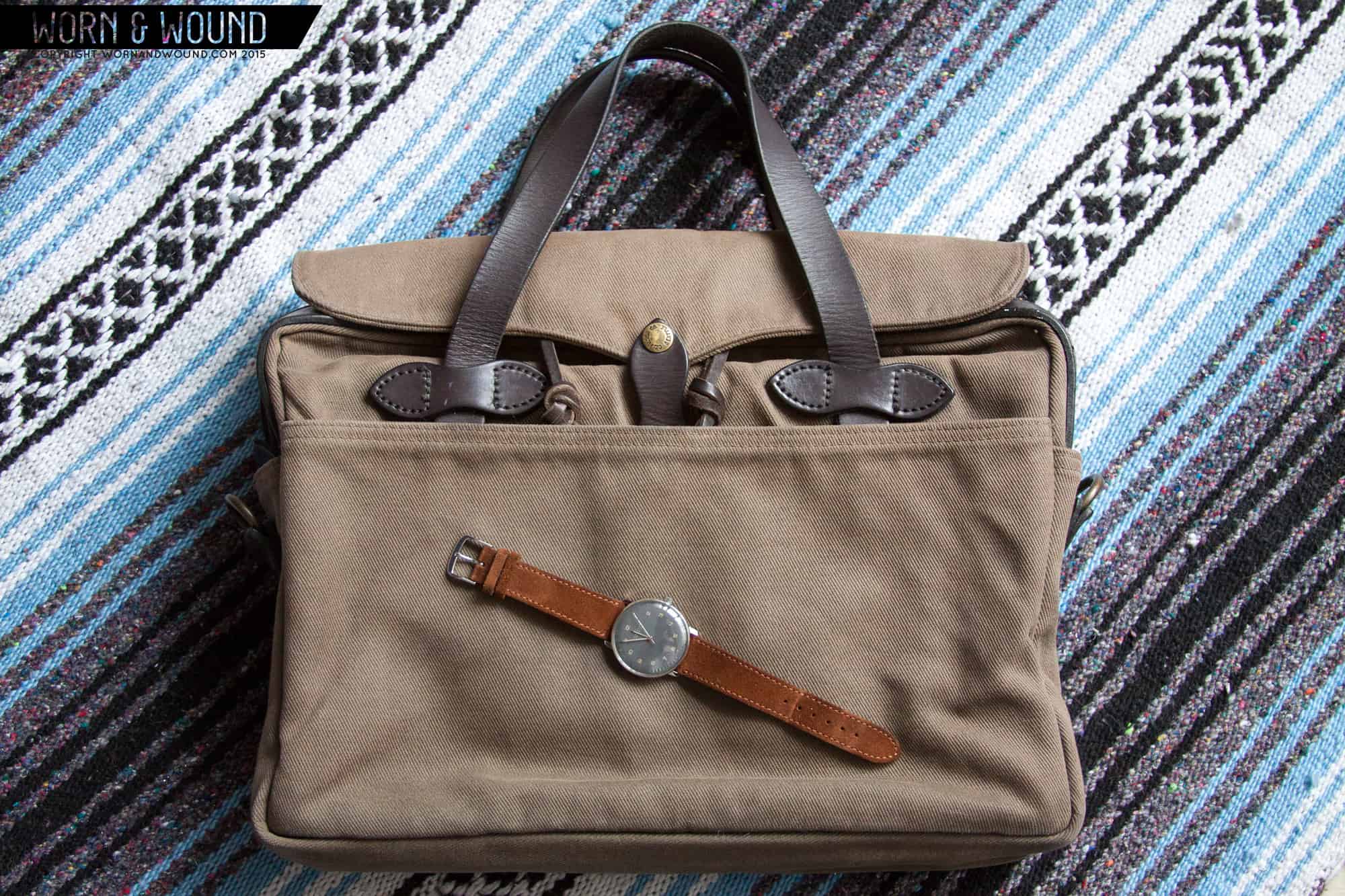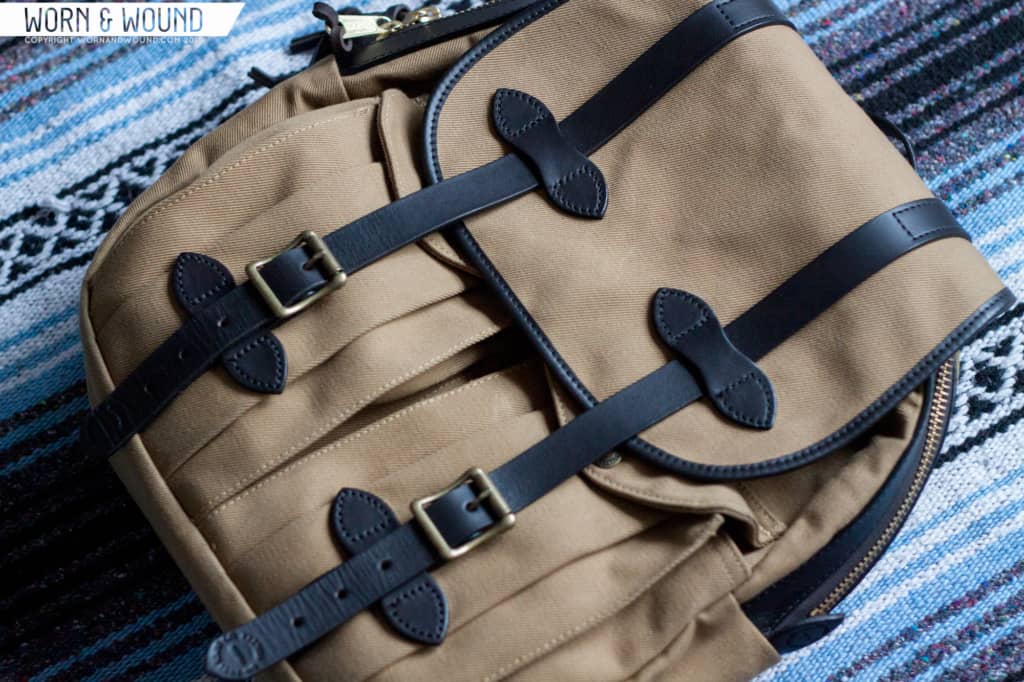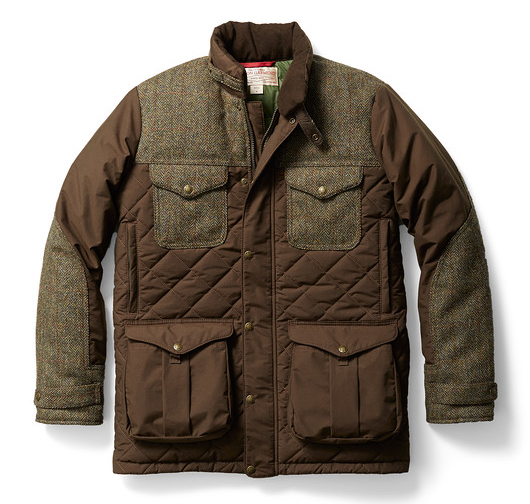Next up on our American-Built series is Filson. Known for creating some of the hardest wearing gear around, Filson is one of the few great American outfitters keeping production largely in the States. You may remember that earlier this year, Filson took its first foray into the world of horology with a line of rugged, yet costly, quartz watches assembled in Detroit by Shinola (read our coverage here).
But when I hear Filson, I don’t think watches. I think, first and foremost, of robust twill luggage and bridle leather, woolen cruiser jackets, and oil-finished tin cloth–things that are meant to last and, like a good timepiece, can be passed down to the next generation (yeah, they’re that tough). So today we’re taking a brief look at the brand’s history, and reviewing one of their most popular products–the original briefcase (256).
History
Few brands can claim a heritage as wonderful and storied as Filson’s. Founded in 1897 by proprietor Clinton C. Filson in Seattle, Washington, Filson (then known as C.C. Filson’s Pioneer Alaska Clothing and Blanket Manufacturers) became the go-to outfitter for prospectors heading up north during the great Klondike Gold Rush. Filson supplied these fortune seekers with all sorts of gear–from clothing and footwear to sleeping bags and blankets–built to withstand the brutal elements of the Yukon.
“To our customers: if a man is going North, he should come to us for his outfit, because we have obtained our ideas of what is best to wear in that country…. Our materials are the very best obtainable, for we know that the best is none too good and that quality is of vital importance. You can depend absolutely upon our goods both as to material and workmanship.”
-1914 Filson Catalogue
After the end of the Gold Rush, Filson took what he learned and started producing gear for a number of different outdoor-based occupations, among them hunting, fishing, and logging. The world-famous Filson Cruiser, for example, was born out of the needs of the timber industry, and to this day remains one of Filson’s most popular items. This tradition of making long-lasting and reliable gear that could handle anything thrown at them carried Filson through the years, establishing it as a trusted brand for outdoorsman and urban dwellers alike.
The Filson family owned Filson for much of the brand’s existence. It first changed leadership in 1970, however, when the family sold their share to a former distributor, who more or less kept the company as is. In 1981, Filson was sold once again, this time to Stan Kohls, a well-known ski entrepreneur at the time. Under Kohls’ direction, Filson’s catalogue grew from a respectable 35 items to an impressive selection of nearly 250 items, all designed by Kohls himself. A long-time admirer of the brand, he was adamant about keeping Filson true to its roots, so much so that he refused to ever allow Velcro on any Filson product.
In 2005, a private equity group out of California, Brentwood Associates, acquired Filson. Focusing primarily on expansion and broadening the appeal of the brand to a larger market, Brentwood brought in former POLO executive Doug Williams as CEO to oversee growth. While the company saw serious development in terms of retail and brand expansion during this period, some of the production was also moved overseas–an unwelcome first for the brand that left many once-loyal customers feeling betrayed.
Finally, in 2012, Bedrock Manufacturing Co., a private equity firm whose portfolio includes Shinola and Steven Alan, purchased the company from Brentwood. Like Brentwood, Bedrock focused on expansion at home and abroad, but did so while bringing production Stateside. Under Bedrock’s and CEO Alan Kirk’s guidance, Filson opened a new manufacturing facility in Seattle in 2013. This move more than doubled Filson’s production capacity, and it created over 100 new jobs. As of today, there are three full-fledged Filson facilities producing wares in the United States.
Original Briefcase 256
The Original Briefcase 256 is a wonderful example of Filson at its best. It’s made from thick 22-oz. twill and sturdy vegetable-tanned bridle leather. The 256 is currently available in 5 colors–classic tan and otter, navy, brown, and black. The black option is paired with matching black leather, with the other four colors featuring brown accents. It’s a sporty look for sure, but one that feels supremely versatile due to the use of darker and earthy tones. The twill cloth starts out stiff, as does the bridle leather, but over time the bag softens up. Bridle leather is especially transformative with continued use, become more pliable all the while developing a beautiful patina (imagine an old, well-loved baseball glove). I’ve seen great examples of 15-year-old bags, well worn but nowhere near tattered.
The 256 is the perfect everyday briefcase, towing the line between business-appropriate and casual–whether you’re in a suit or in a pair of jeans, the 256 will look right at home. It’s also deceptively spacious, coming in at 16″ x 12-1/2″ x 4″. It has two open outer pockets, ideal for holding a magazine or newspaper. The interior compartment is more secure, protected by one of the sturdiest two-way brass zippers I have ever encountered, and additionally secured via a storm flap for those rainy commutes home.
Internally, the bag is broken up into three sections, with the central compartment being the largest sandwiched between two smaller interior pockets. On a regular day, I can fit a book, two smaller notebooks, my 13-inch laptop and all necessary cords and chargers with ease. One of the interior dividers comes affixed with smaller pockets for pens and business cards and other miscellanea (how about a watch?).
The 256 is a bit on the heavier side to start with seeing as how bridle leather and 22-oz. twill will easily outweigh most synthetic cloths, but it’s still quite comfortable for daily use and not at all overbearing. The two hand straps fit my grip well, but Filson offers the option of getting a handgrip installed for a small surcharge if you find the bare straps uncomfortable. The 256 also comes with a padded shoulder strap, which attaches via two rings on the sides of the bag. You have the option of wearing it like a messenger bag, but it’s not something I’ve found to be particularly comfortable, though I have seen others do it quite often.
Overall, you won’t go wrong with any Filson product, and while they may be pricey, they are certainly built to last. The 256 is one such item, and it’s a great choice for daily use. It’s well made and durable, and you can pass it on to your kids along with your most valued timepiece. If you already own a well-loved Filson product, we’d love to see a photo in our comments section below.









 Featured Videos
Featured Videos













